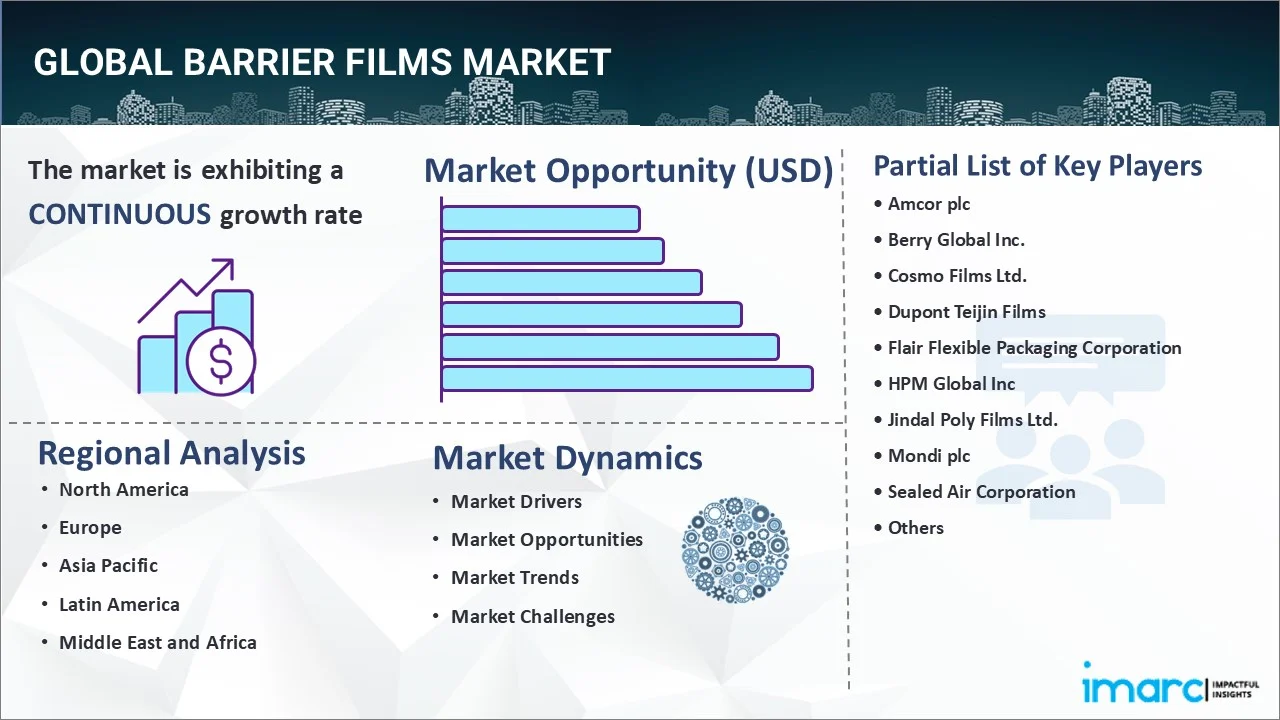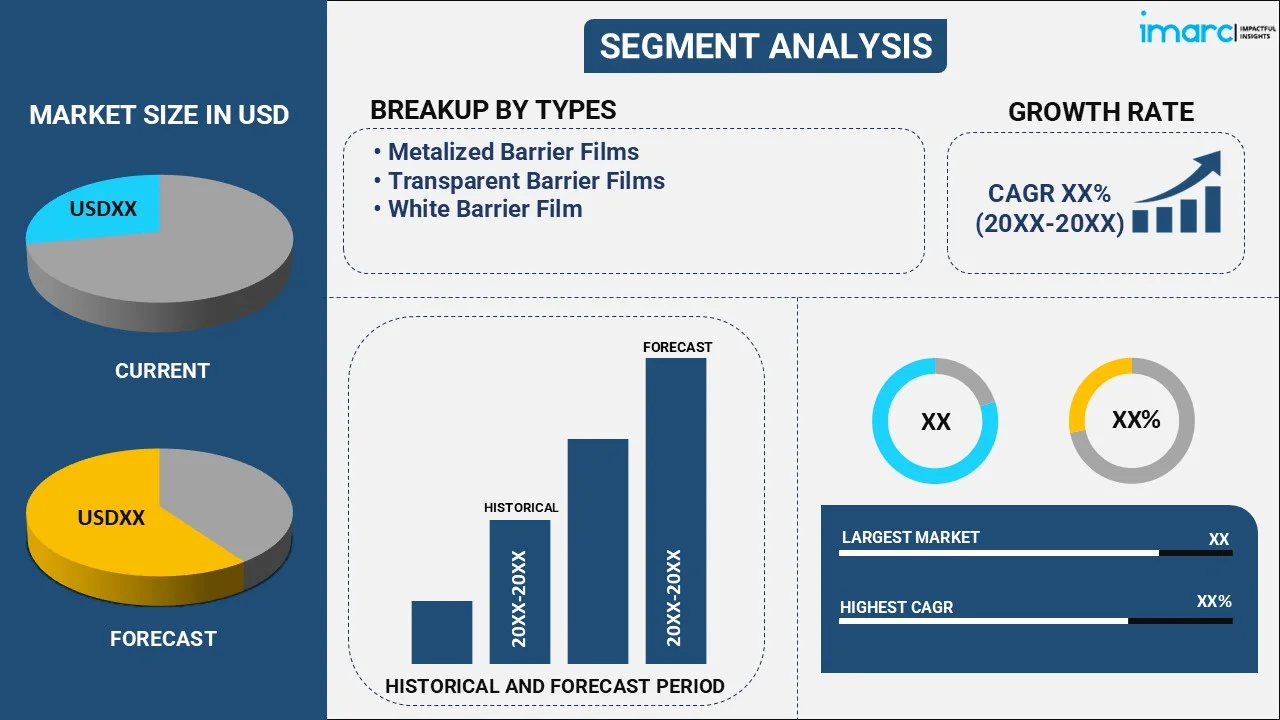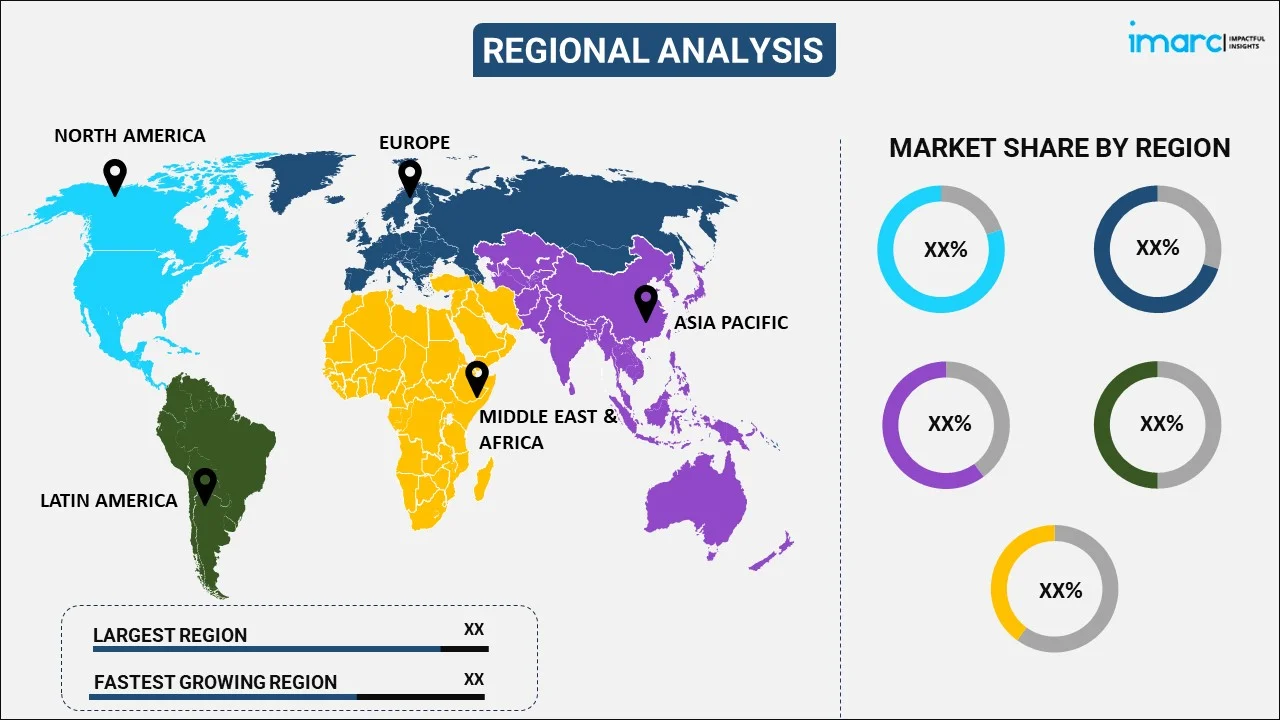
Barrier Films Market Report by Type (Metalized Barrier Films, Transparent Barrier Films, White Barrier Film), Material (Polyethylene Terephthalate (PET), Polyethylene (PE), Polypropylene (PP), Polyamides (PA), Ethylene Vinyl Alcohol (EVOH), Linear Low-Density Polyethylene (LLDPE), and Others), End Use (Food and Beverage Packaging, Pharmaceutical Packaging, Agriculture, and Others), and Region 2025-2033
Market Overview:
The global barrier films market size reached USD 36.5 Billion in 2024. Looking forward, IMARC Group expects the market to reach USD 54.0 Billion by 2033, exhibiting a growth rate (CAGR) of 4% during 2025-2033. The increasing demand for packaged food and beverages (F&B), recent advancements in pharmaceutical packaging, significant growth in e-commerce platforms, escalating demand for portable and lightweight packaging solutions, and globalization of supply chain are some of the major factors propelling the market.
|
Report Attribute
|
Key Statistics
|
|---|---|
|
Base Year
|
2024 |
|
Forecast Years
|
2025-2033
|
|
Historical Years
|
2019-2024
|
| Market Size in 2024 | USD 36.5 Billion |
| Market Forecast in 2033 | USD 54.0 Billion |
| Market Growth Rate 2025-2033 |
4%
|
Barrier films refer to specialized packaging materials designed to control the permeation of gases, moisture, or light, thereby extending the shelf-life and maintaining the quality of the packaged contents. It includes polyethylene (PE), polypropylene (PP), polyvinyl chloride (PVC), and ethylene vinyl alcohol (EVOH), each offering unique barrier properties. Barrier films are widely used in food packaging, pharmaceuticals, electronics, agriculture, cosmetics, vacuum insulation panels, solar cells, flexible displays, and gas separation. They are cost-effective, durable, and versatile products that aid in prolonging shelf-life, maintaining freshness, and preventing spoilage.

The widespread product adoption due to the escalating demand for portable and lightweight packaging solutions in various industries, such as consumer goods and automotive, is propelling the market growth. Additionally, the recent technological innovations resulting in new types of barrier films with specialized functionalities, such as antimicrobial or flame-retardant properties, are contributing to the market growth. Furthermore, the globalization of supply chains, which require more robust packaging solutions to ensure product safety and quality during longer transit times, is acting as another growth-inducing factor. Furthermore, the widespread product utilization in automotive industry for battery packaging, where moisture and oxygen control are essential. Besides this, the increasing product utilization in the cosmetics industry for protective and aesthetically pleasing packaging is strengthening the market growth.
Barrier Films Market Trends/Drivers:
The increasing demand for packaged food and beverages (F&B)
The heightened demand for packaged food and beverages (F&B) is a significant factor propelling the barrier films market. Lifestyle changes and urbanization are increasing the dependency on packaged goods for both convenience and preservation of product quality. Barrier films, with their ability to restrict the ingress of moisture, oxygen, and light, serve as an ideal solution for these packaging challenges. They ensure that food and beverages (F&B) retain their flavor, texture, and nutritional value, thereby considerably extending the shelf life. Furthermore, the increasing utilization of barrier files as they help to preserve the quality and integrity of products, which in turn is acting as another growth-inducing factor.
The recent advancements in pharmaceutical packaging
The advancement in pharmaceutical packaging is a vital driver in the growth of the barrier films market. Medications are becoming more specialized, and many require stringent environmental controls to maintain their efficacy. In line with this, barrier films provide the essential blockage against moisture, light, and oxygen, which are known to degrade pharmaceutical products. Furthermore, these films are particularly crucial for drugs that are sensitive to environmental factors and for products that need to be stored and transported under strict conditions. Additionally, regulatory agencies across the globe are implementing stringent guidelines on pharmaceutical packaging, further necessitating the use of high-quality barrier films to meet compliance standards. Moreover, the growing awareness of patient safety and medication effectiveness also emphasizes the importance of proper packaging, thereby bolstering the adoption of barrier films.
The significant growth in e-commerce platforms
The convenience of e-commerce has led to an unprecedented demand for packaging solutions that can withstand the rigors of long-distance transportation, multiple handling points, and varied environmental conditions. Barrier films provide the necessary mechanical strength and protective features required for these challenges. They safeguard the product from environmental factors like humidity and temperature fluctuations, which are crucial when shipping sensitive items, such as electronics, cosmetics, or perishable goods. Moreover, the rise of e-commerce has also witnessed an increase in consumer expectations for quick deliveries without compromising product quality. Barrier films ensure that products reach the consumer in optimum condition, thus playing a vital role in satisfying these expectations and, by extension, contributing to the ongoing expansion of the e-commerce sector.
Barrier Films Industry Segmentation:
IMARC Group provides an analysis of the key trends in each segment of the global barrier films market report, along with forecasts at the global, regional, and country levels for 2025-2033. Our report has categorized the market based on type, material, and end use.
Breakup by Type:

- Metalized Barrier Films
- Transparent Barrier Films
- White Barrier Film
The report has provided a detailed breakup and analysis of the market based on type. This includes metalized barrier films, transparent barrier films, and white barrier film.
Metalized barrier films are highly effective in blocking moisture, oxygen, and light. This superior barrier function is especially critical in the food and pharmaceutical sectors, where maintaining the integrity and shelf-life of products is a primary concern. Furthermore, they offer a cost-effective alternative to foil-based laminates while still providing comparable barrier properties. Additionally, the aesthetic appeal of metalized films, with their glossy and premium finish, attracts consumer attention, making them a preferred choice for packaging luxury goods and high-quality products.
Transparent barrier films allow for easy product visibility, which is a significant advantage in retail settings. Consumers often prefer to see the actual product before purchase, making transparent barrier films a favored choice in food and consumer goods packaging. Additionally, the advancements in material science have enabled transparent films to achieve excellent barrier properties without the need for opaque materials. Besides this, transparent barrier films are highly adaptable and can be used in conjunction with other materials in multi-layer packaging solutions.
Breakup by Material:
- Polyethylene Terephthalate (PET)
- Polyethylene (PE)
- Polypropylene (PP)
- Polyamides (PA)
- Ethylene Vinyl Alcohol (EVOH)
- Linear Low-Density Polyethylene (LLDPE)
- Others
Polyethylene (PE) hold the largest share in the market
A detailed breakup and analysis of the market based on material has also been provided in the report. This includes polyethylene terephthalate (PET), polyethylene (PE), polypropylene (PP), polyamides (PA), ethylene vinyl alcohol (EVOH), linear low-density polyethylene (LLDPE), and others. According to the report, polyethylene (PE) represented the largest segment.
Polyethylene is known for its excellent moisture barrier properties, which are crucial for packaging perishable goods like food and pharmaceuticals, where moisture ingress can adversely affect product quality and shelf life. Additionally, it is cost-effective to produce, making it an attractive option for companies aiming to control manufacturing costs without compromising on quality. Furthermore, polyethylene exhibits high chemical resistance, which makes it suitable for applications involving contact with various substances, including acids, alkalis, and solvents. Besides this, polyethylene films offer a good degree of mechanical strength and durability, providing the required toughness for packaging that withstands transportation, handling, and other stresses. Along with this, it is highly flexible and can be easily adapted into various forms and sizes, offering versatility in packaging design.
Breakup by End Use:
- Food and Beverage Packaging
- Pharmaceutical Packaging
- Agriculture
- Others
Food and beverage packaging holds the largest share in the market
A detailed breakup and analysis of the market based on end use has also been provided in the report. This includes food and beverages packaging, pharmaceutical packaging, agriculture, and others. According to the report, food and beverage packaging accounted for the largest market share.
Barrier films are widely used in food and beverage (F&B) packaging as they offer excellent resistance against moisture, oxygen, and light, all of which contribute to the degradation of food items. Furthermore, barrier films offer aesthetic advantages to F&B products, such as clarity and a premium look, which are valuable for brand positioning in a competitive market. Additionally, they meet the stringent regulations imposed by food safety authorities, ensuring that the packaged contents are free from contamination. Besides this, the growing international trade of food and beverages (F&B) necessitates packaging that can withstand long shipping times and varying environmental conditions. Barrier films offer the required mechanical strength and protective attributes, ensuring that products reach global markets in optimal condition.
Breakup by Region:

- North America
- United States
- Canada
- Asia Pacific
- China
- Japan
- India
- South Korea
- Australia
- Indonesia
- Others
- Europe
- Germany
- France
- United Kingdom
- Italy
- Spain
- Russia
- Others
- Latin America
- Brazil
- Mexico
- Others
- Middle East and Africa
Asia Pacific exhibits a clear dominance, accounting for the largest barrier films market share
The market research report has also provided a comprehensive analysis of all the major regional markets, which include North America (the United States and Canada); Asia Pacific (China, Japan, India, South Korea, Australia, Indonesia, and others); Europe (Germany, France, the United Kingdom, Italy, Spain, Russia, and others); Latin America (Brazil, Mexico, and others); and the Middle East and Africa. According to the report, Asia Pacific accounted for the largest market share.
Asia Pacific has witnessed a rise in industrial activities, creating a high demand for packaging solutions, including barrier films. Furthermore, the region has a burgeoning food and beverage (F&B) industry, which requires effective packaging solutions to extend shelf life and preserve quality. Along with this, the growing demand for packaged goods due to the increasing middle-class population and disposable incomes is acting as another growth-inducing factor. Additionally, local manufacturers are investing in research and innovation to produce high-quality barrier films, making the region self-sufficient and even an exporter. Besides this, the manufacturing costs in Asia Pacific are relatively low, which makes the production of barrier films more cost-effective compared to other regions. Moreover, the imposition of supportive policies by regional governments encouraging manufacturing activities is supporting the market growth.
Competitive Landscape:
Several companies are investing in research and innovation to create more efficient and sustainable barrier film solutions. Furthermore, they are looking at improving characteristics such as barrier properties, biodegradability, and recyclability. Additionally, leading players are engaging in merger and acquisition (M&A) activities to expand their product portfolio and reach. Along with this, they are increasingly focusing on meeting specific customer needs, offering customized solutions for various applications like food packaging, pharmaceuticals, and electronics. Besides this, leading companies are developing eco-friendly barrier films that are either recyclable or biodegradable to attract eco-conscious consumers. Moreover, companies are forming alliances and partnerships with material suppliers, technology providers, and even competitors to collectively advance the technology and lower costs. Apart from this, they are improving their quality control and assurance mechanisms to gain customer trust and regulatory approval.
The report has provided a comprehensive analysis of the competitive landscape in the market. Detailed profiles of all major companies have also been provided. Some of the key players in the market include:
- Amcor Plc
- Berry Global Inc.
- Cosmo Films Ltd.
- Dupont Teijin Films
- Flair Flexible Packaging Corporation
- HPM Global Inc
- Jindal Poly Films Ltd.
- Mondi plc
- Sealed Air Corporation
- Toppan Inc.
Recent Developments:
- In February 2023, Amcor plc launched a new thermoforming film, which offers meat and dairy brands excellent packaging performance.
- In July 2023, Berry Global Inc. launched a new version of its high-performance NorDiVent FFS film for powdered products.
- In November 2021, Cosmo Films Ltd. launched enhanced barrier metalized BOPP film for packaging applications.
Barrier Films Market Report Scope:
| Report Features | Details |
|---|---|
| Base Year of the Analysis | 2024 |
| Historical Period | 2019-2024 |
| Forecast Period | 2025-2033 |
| Units | Billion USD |
| Scope of the Report | Exploration of Historical Trends and Market Outlook, Industry Catalysts and Challenges, Segment-Wise Historical and Predictive Market Assessment:
|
| Types Covered | Metalized Barrier Films, Transparent Barrier Films, White Barrier Film |
| Materials Covered | Polyethylene Terephthalate (PET), Polyethylene (PE), Polypropylene (PP), Polyamides (PA), Ethylene Vinyl Alcohol (EVOH), Linear Low-Density Polyethylene (LLDPE), Others |
| End Uses Covered | Food and Beverage Packaging, Pharmaceutical Packaging, Agriculture, Others |
| Regions Covered | North America, Asia Pacific, Europe, Latin America, Middle East and Africa |
| Countries Covered | United States, Canada, Germany, France, United Kingdom, Italy, Spain, Russia, China, Japan, India, South Korea, Australia, Indonesia, Brazil, Mexico |
| Companies Covered | Amcor plc, Berry Global Inc., Cosmo Films Ltd., Dupont Teijin Films, Flair Flexible Packaging Corporation, HPM Global Inc, Jindal Poly Films Ltd., Mondi plc, Sealed Air Corporation, Toppan Inc., etc. |
| Customization Scope | 10% Free Customization |
| Post-Sale Analyst Support | 10-12 Weeks |
| Delivery Format | PDF and Excel through Email (We can also provide the editable version of the report in PPT/Word format on special request) |
Key Benefits for Stakeholders:
- IMARC’s industry report offers a comprehensive quantitative analysis of various market segments, historical and current market trends, market forecasts, and dynamics of the barrier films market from 2019-2033.
- The research report provides the latest information on the market drivers, challenges, and opportunities in the global barrier films market.
- The study maps the leading, as well as the fastest-growing, regional markets. It further enables stakeholders to identify the key country-level markets within each region.
- Porter's five forces analysis assist stakeholders in assessing the impact of new entrants, competitive rivalry, supplier power, buyer power, and the threat of substitution. It helps stakeholders to analyze the level of competition within the barrier films industry and its attractiveness.
- Competitive landscape allows stakeholders to understand their competitive environment and provides an insight into the current positions of key players in the market.
Key Questions Answered in This Report
The global barrier films market was valued at USD 36.5 Billion in 2024.
We expect the global barrier films market to exhibit a CAGR of 4% during 2025-2033.
The rising consumer preference for barrier films over conventional films, such as resealable zippers and sliders, as they offer faster machining speed, increased heat tolerance, extended shelf-life, etc., is primarily driving the global barrier films market.
The sudden outbreak of the COVID-19 pandemic had led to the implementation of stringent lockdown regulations across several nations, resulting in the temporary closure of numerous production activities for barrier films.
Based on the material, the global barrier films market has been segregated into Polyethylene Teraphthalate (PET), Polyethylene (PE), Polypropylene (PP), Polyamides (PA), Ethylene Vinyl Alcohol (EVOH), Linear Low-Density Polyethylene (LLDPE), and others. Among these, Polyethylene (PE) currently exhibits a clear dominance in the market.
Based on the end use, the global barrier films market can be bifurcated into food and beverage packaging, pharmaceutical packaging, agriculture, and others. Currently, the food and beverage packaging industry holds the largest market share.
On a regional level, the market has been classified into North America, Asia-Pacific, Europe, Latin America, and Middle East and Africa, where Asia-Pacific currently dominates the global market.
Some of the major players in the global barrier films market include Amcor plc, Berry Global Inc., Cosmo Films Ltd., Dupont Teijin Films, Flair Flexible Packaging Corporation, HPM Global Inc, Jindal Poly Films Ltd., Mondi plc, Sealed Air Corporation, and Toppan Inc.
Need more help?
- Speak to our experienced analysts for insights on the current market scenarios.
- Include additional segments and countries to customize the report as per your requirement.
- Gain an unparalleled competitive advantage in your domain by understanding how to utilize the report and positively impacting your operations and revenue.
- For further assistance, please connect with our analysts.
 Request Customization
Request Customization
 Speak to an Analyst
Speak to an Analyst
 Request Brochure
Request Brochure
 Inquire Before Buying
Inquire Before Buying




.webp)




.webp)












